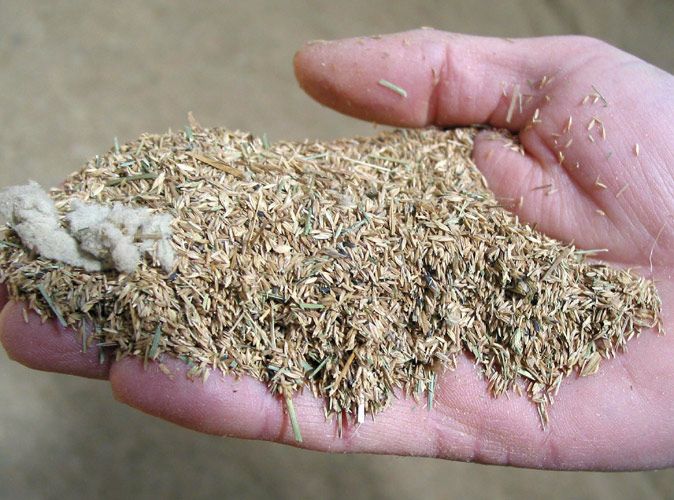From cleaning to greening
Published 12:46 pm Saturday, February 23, 2008

- FRESH FROM THE FIELD: This handful of flotsam and jetsam also holds hundreds of tiny little Kentucky bluegrass seeds within the clumps of cotton, straw clippings, rocks, dirt, sand and weed seeds. All superfluous material will be painstakingly cleaned at one of two facilities owned by Blue Mountain Seeds. - Observer photos/MARDI FORD
IMBLER – Blue Mountain Seeds grass seed may cover the world, but it goes through a very intensive cleaning process before it’s ready to plant.
Trending
Since mid-July the grass seed cleaning operation at Blue Mountain Seeds has been running 24 hours a day, seven days a week. In the end, the Imbler operation’s 2007 grass seed harvest will generate well over 10 million pounds of clean seed. It is one of several seed cleaning facilities in the county.
Most of Blue Mountain’s grass seed grown under the azure sky and golden sun of Union County will result in more than 75,000 acres of crisp green ball fields, parks and lawns on the other side of the continent – in New Jersey, New York and Illinois.
Some of it will cross the Atlantic in containers destined for far away places most Union County residents will never see – like Switzerland and the more exotic locations of Turkey and China.
Trending
Of the two Blue Mountain Seeds cleaning facilities, the larger Hayes Road plant devotes itself to Kentucky bluegrass – 40 varieties this year. It will continue to run through March, says general manager Bill Merrigan.
The smaller plant in Imbler primarily cleans the fine leaf fescue crops – 18 varieties this year. By mid-February that facility is mostly finished with cleaning, bagging and tagging. Only the shipping remains.
Mike Miller has been the seed cleaning plant manager at Blue Mountain Seeds for 34 years. Merrigan says Miller is unique in the passionate commitment he brings to his vocation.
“It’s more than just a job to Mike,” says Merrigan, adding that Miller is well-respected and trusted by the growers who depend on him for the finished product for which they will be paid.
From harvest to spring, Miller’s job is to make sure the growers get the best yield possible. Blue Mountain Seeds also depends on Miller to clean that seed efficiently and cost effectively for the price they’ve contracted. And the customer who buys the seed wants Miller’s end result to be of the highest quality possible according to industry standards..
“It’s a balancing act,” admits Miller.
Merrigan says the old saying that you can’t make a silk purse out of a sow’s ear is a favorite in the seed business.
“We’ve been blessed with good growers,” he says, but adds even the best of growers face unexpected conditions over which they have no control. For example, the 2007 harvest saw more widespread ergot fungus than had ever been seen in the valley before. Sticky and tenacious, ergot has caused many headaches in the field and in the cleaning process. Blue Mountain Seeds is still running second cleanings to remove as much ergot from the seed as possible.
The plant runs approximately 1,000 pounds per hour through an extended and complicated -to the casual observer, anyway -process. Both Merrigan and Miller admit they could run at a higher level than that, but the headaches that come from doing so during the process don’t seem to save them money or time in the end.
Each step in the process, they say, is simply designed as one more step to remove chaff, weed seed, sand, dirt, straw, cotton – and even an occasional plastic water bottle inadvertently left in the field – from the teeny, tiny little grass seeds.
Once summer harvest begins, farm trucks arrive with freshly combined seed that is weighed and assigned a number that will identify that lot from the field to the bag. At any time, seed can be retraced all the way back to the field it came from and the farmer who grew it.
Stored in dozens of bins holding from 80,000 to 100,000 thousand pounds of seed each, Blue Mountain Seeds’ warehousing capability is expansive. Although the operation has grown over the past 30 years, the process and technology used is much the same as it was back in 1971 when the plant was built.
“The new machines may be made of fiber glass and metal, but the technology they use is the same as the old ones built from oak,” Miller says.
Bucket loader operators scoop seed from the bins and fill the hoppers. Then the seed runs through a debearder that works similar to the cylinder on a combine. The debearder knocks more of the rough stuff off and out of the way and the seed moves on to the scalper. On the scalper, air hoses alternately blow and vacuum the lighter unwanted material away from the seed as screens and shakers filter out fine dirt, sand and larger pieces of straw. Next comes more air and conveyor belts, hoses, shakers, gravity decks. Cylinders with cast iron disc separators and knives – all working and gyrating, shaking and grinding away to separate out a little more sand, weed seed and tiny, little rocks.
Each step in the process is fine tuned and balanced under the careful guidance and watchful eye of Miller and his 34 years of experience.
“In the end, we’re only as good as our growers,” he says modestly. “What comes in the front end can make my job either a tough one or an easy one.”
His philosophy for grass seed cleaning is really sound wisdom for living.
“First, do no harm,” Miller says. “Next, treat it like it’s your own. And finally, don’t become complacent.”









